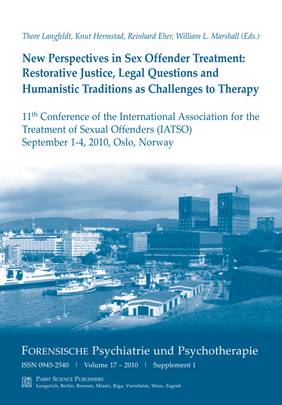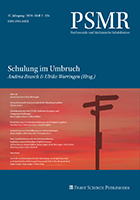"New Perspectives in Sex Offender Treatment: Restorative Justice, Legal Questions and Humanistic Traditions as Challenges to Therapy"
11th Conference of the International Association for the Treatment of Sexual Offenders (IATSO)
September 1-4, 2010, Oslo, Norway
- Abstracts -
Contents
Calculating risk: an overview of dynamic models and the integration of causal and survival models
O. O. Aalen
Mental disorders among incarcerated paedophiles
T. Adiele, C. M. Davidson, E. del Busto, M. C. Harlow
Young people who sexually abuse: A research in Portuguese residential institutions
R. G. Barroso, C. Manita, P. Nobre
Treatment of consumers of illegal pornography: More than relapse prevention
C. Benz
Attachment and sexual delinquency
W. Berner
The decoding of womens non-verbal cues by rape-prone men
E. Blake, T. Gannon
Arguments regarding a convergent approach to sexual violence risk assessment
D. P. Boer
Multisystemic therapy with juvenile sexual offenders: clinical and cost effectiveness
C. M. Borduin
Dogmatic beliefs in religion, psychoanalysis and law preventing sex offenders therapy
I. Boschi
Pharmacotherapeutic options for sexual offenders
P. Briken
NOT IN MY NEIGHBORHOOD: Assessing registered sex offenders experiences with local social capital and social control
K. B. Burchfield, W. Mingus
The effectiveness of assessment instruments in measuring change in intellectually disabled sex offenders
V. M. Burrett, J. Sakdalan, D. P. Boer
Polygraph testing internet offenders
J. Buschman, D. Wilcox
PTSD under-diagnosed in sexual offenders: The impact of bias, or narrow focus on risk and management
S. Cann, R. Konopasky
Working together to prevent sexual recidivism
S. Catanese
The role of attachment, interpersonal motivational systems and theory of mind in the sexual aggressor-victim relationship
N. Castellino, M. Zaccagnino, F. Veglia
Female sexual offenders are different
F. Cortoni
Empathy for the devil?
K.-P. David, H. Bovensmann
Protective factors for (sexual) violence. Results with the SAPROF in a sample of sexual offenders
V. de Vogel, M. de Vries Robbé
American chemical castration laws: Legal, ethical and medical issues
E. del Busto, M. C. Harlow, T. Adiele, W. Seabloom, C. M. Davidson
The American female sex offender: Not just a taboo
E. del Busto, M. C. Harlow, S. Margery, T. Adiele, C. M. Davidson
Forensic sexology in Poland. Critical review
J. Drelicharz, J. K. Gierowski
Clinical aspects of risk assessment in pedosexual offenders
R. Eher
Is the consumption of child pornography a risk factor for child sexual abuse?
J. Endrass, A. Rossegger
"First Ill pick the potatoes: When meaning and trust is offended, how can reflecting processes and new dialogical paths be explored and developed among those involved after sexual abuse towards children from their trusted adults?
A. M. Flåm
Body-oriented psychotherapy in the treatment of sexual offenders
U. Franz, A. Radandt
Hebephilia is a mental disorder??
R. Green
Sexual offence recidivism and expert guidance to the courts: Separating folklore and junk science from science, illustrated by a high-profile case in Norway
P. Grøndahl
Psychopathic characteristics and sexual deviancy in pedophilic and hebephilic child pornography offenders
D. Grundmann, J. Neutze, K. M. Beier
On the Hypersexual Disorder Inventory (HDSI) in a Swedish group of self-reported hypersexual men and women. Preliminary data
J. Hallberg, K. Öberg
Meta-analysis of treatment outcome in sexual offenders
K. R. Hanson
Treating sex offenders: The morality and legality of treatment methods
K. Harrison, B. Rainey
Enabling environment for sex offenders in prison
B. Hasselrot, C. Fielding
Sexual offences, law and moral - can behavior and attitudes be changed by legal and moral efforts?
K. Hermstad
Circles NL - Circles Together for Safety; COSA in the Netherlands and Europe
Höing, M.
Sex offenders from the Jewish Haredi Community in Israel: Assessment and treatment issues
Y. Idisis, S. Oz
Diagnosis, assessment, and treatment of hypersexuality
M. S. Kaplan, R. B. Krueger
Socio-demographic and diagnostic characteristics of homicidal and non-homicidal sexual offenders
J. Koch, P. Briken, W. Berner, A. Hill
Indirect sexual preference measurement on child molesters today: A critical review and research proposition
S. Koeck
Sexual homicide - The offender or the offense?
F. Koenraadt
True informed consent for treatment: Information, evidence, comparison, and path to complaint
A. Konopasky, R. Konopasky
Treatment for the treatment provider: Resilience, a by-product of positive psychology, can be trained in the sexual offender therapist
A. Konopasky, R. Konopasky, E. Ford
Establishing the nexus between sexual assault and damages in civil suits: Reasoning, challenges, and responses to challenges
R. Konopasky, J. McKinlay, T. Barrett
Successful sexual offender therapy: No civil suits and no disciplinary measures against the therapist
R. Konopasky, J. McKinlay
For sexual offenders, is good treatment no recidivism, cheaply bought, or is it treatment that best serves the sexual offender and society no matter the cost: A debate
R. Konopasky, D. Millar
New developments in the diagnosis of sexual masochism and sexual sadism
R. B. Krueger
Use of sexually explicit and non-explicit images of children and associated risk factors for child sexual abuse
L. Kuhle, J. Neutze, K. M. Beier
Content of pedophilic and hebephilic sexual fantasies and its impact on child sexual abusive behavior
T. Kutscher, J. Neutze, K.-P. Dahle, K. M. Beier
Transference Focused Psychotherapy (TFP) with sexual offenders
F. Lackinger
The homosexual dilemma in the Catholic Church
T. Langfeldt
Childhood, attachment and development of sexual offensive behaviour: Implications for therapy
T. Langfeldt
Sex offending in South Africa - Towards a data driven prevention model
T. Majokweni, B. Lawrence
Cognitive distortions in child molesters: Should they all be treatment targets
W. L. Marshall
Does having sexual offenders complete more than one treatment intensity level increase reductions in recidivism?
L. E. Marshall, J. Looman, E. Peacock
A therapist rating scale for determining treatment-induced change
L. E. Marshall, W. L. Marshall, S. Humphries, G. Serran, M.D. OBrien
Sexual desires and beliefs about social acceptability in incarcerated sexual offenders
L. E. Marshall, M. D. OBrien, W. L. Marshall
Predictive and incremental validity of the STABLE-2000 and the STABLE-2007 in an Austrian sample of child sexual abusers
A. Matthes, M. Rettenberger, R. Eher
Empirical validation of the COPINE Scale as a research tool
H. L. Merdian, D. P. Boer, N.J. Wilson
From talking to feeling
F. Mielke, K.-P. David
From thinking to feeling and experiencing: Innovative methods for working with juvenile sex offenders
F. Mielke, K.-P. David
Restoring justice: The art of hating
D. Millar
Piercing the sexual offence veil, in polygamous marriages
M. T. Mpanza
Treatment of sex offenders in the prison system of the Republic of Croatia
L. Muzinic, L. Vukota, B. G. Korotaj
Dynamic risk factors in undetected help seeking pedophiles and hebephiles
J. Neutze, D. Grundmann, G. A. Schaefer, K. M. Beier
Comparison of characteristics of rapists in prison and forensic settings: Is there a difference?
J. Nitschke, A. Mokros, M. Osterheider
Psychiatric co-morbidity and sexual paraphilia in a group of Swedish men and women with hypersexual disorder. Preliminary data
K. Öberg, J. Hallberg
Development of and preliminary result from KAOS, a cognitiv behaviour program for mentally disabled sexual offenders in forensic care
S. Øverland, P. B. Olsen
Mandated reporting laws: Their impact on interventions in child sexual abuse
S. Oz
A cognitive-behavioral conceptualization of hypersexuality
N. Paunovic
Dealing with the hidden burden of incest
K. T. Pettersen
Shame within the context of child sexual abuse
K. T. Pettersen
Psychotherapy research in forensic settings
F. Pfäfflin
Application of the Massachusetts Treatment Centre Revised Rapist Typology to New Zealand high-risk Rapists: A pilot study
S. L. Reid, N. J. Wilson, D. P. Boer
Current developments in actuarial risk assessment for sexual offenders: Static-99 and age
M. Rettenberger, T. Haubner, R. Eher
The Norwegian penal codes special measure "Mandatory Care
E. Revis
Treatment for adult sex offenders: May we reject the null hypothesis?
M. E. Rice
Criminal behavior patterns of adolescents and young adults who have histories of sexual offenses
S. T. Ronis, C. M. Borduin
Risk Matrix 2000 validation on an Italian sample: A work in progress
C. Rosso, M. Garombo, N. Castellino, S. Salvadori, L. Bastiani, A. Contarino, P. Garofano, F. Corti, M. T. Molo, F. Veglia
Cognitive distortions in pedophilic child molesters: Modification validation of the first German cognitive distortions questionnaire
S. Scherr, R. Alexandrowicz, R. Eher
Sexual sadism: Data on validity and reliability of a screening instrument based on file-information
F. Schilling, T. Ross, F. Pfäfflin, R. Eher
The firefly jar they live in: Children and adolescents in sexual crisis, recent recidivism findings and the voices of the children
W. Seabloom
Telephone hotline for adults with a sexual interest in children: A review of the first 4 years. 2006-2010
R. K. Simonsen, E. Kristensen
Attachment insecurity as a predisposing and precipitating factor for sexual offending
S. Smallbone, N. McKillop, R. Wortley
Clinical indicators for sex offender treatment and their relationship to risk
W. J. Smid
Specific age preferences in child molesters
W. J. Smid
Sexual deviance, antisocial orientation and victim age
W. J. Smid
Type of cognitive distortion and recidivism
W. J. Smid
Female sex offenders: Assessment and treatment
C. Steen
The HOW is much more important than the WHAT in the treatment of sex offenders
L. Studer
Culture and sexual offender rehabilitation: A New Zealand perspective
A. Tamatea, M. Webb, D. P. Boer
"State of Mind regarding attachment in a group of 45 adolescents who have sexually offended
I. Tidefors
Management of side effects of Androgen deprivation therapy in sex offenders
J. A. Troelstra
40 Year of history: Czech model of sexological treatment
O. Trojan, M. Hollý
Are there any clinical implications to be drawn from indirect measures of sexual interest? Data from the Explicit and Implicit Sexual Interest Profile (EISIP)
K. Vanhoeck, A. F. Schmidt, R. Banse
Evaluations of sexual offenders: How stereotypical bias may affect assessments of risk and treatment need
C. Weber Malmberg
Case studies in the utility of the polygraph
D. Wilcox, J. Buschman
Bayesian reasoning protects against confirmatory biases and illusions of certainty in sex offender risk assessments
R. Wollert
Against risk-only risk assessment
D. Yoon, A. Spehr, P. Briken























